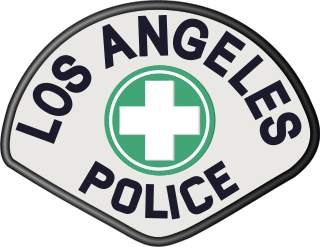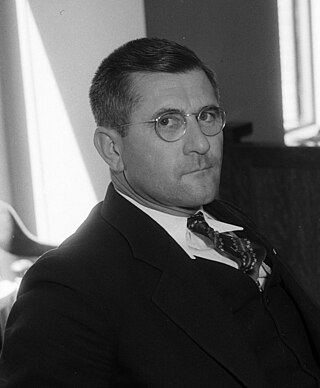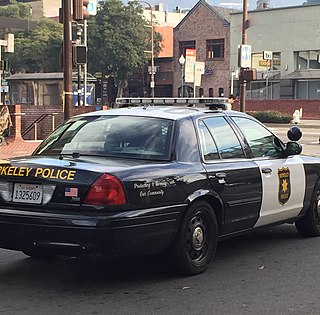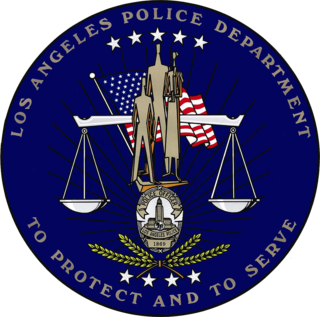
The Los Angeles Police Department (LAPD), officially known as the City of Los Angeles Police Department, is the municipal law enforcement agency of Los Angeles, California, United States. With 9,974 officers and 3,000 civilian staff, it is the third-largest municipal police department in the United States, after the New York City Police Department and the Chicago Police Department.

George Edward Cryer was an American lawyer and politician. A Republican, Cryer served as the 32nd Mayor of Los Angeles from 1921 to 1929, a period of rapid growth in the city's population. During his administration, the Los Angeles City Hall and Los Angeles Memorial Coliseum were built, and the city's population surpassed 1,000,000. Prior and subsequent to serving as mayor, he was a lawyer. Between 1929 and 1931, Cryer became engaged in a widely publicized libel court case with the Reverend Robert P. Shuler, a radio evangelist who accused Cryer of being a "grafter" who had entered office a poor man and left office a millionaire.

Daryl Francis Gates was the Chief of the Los Angeles Police Department (LAPD) from 1978 to 1992. His length of tenure in this position was second only to that of William H. Parker. Gates is co-credited with the creation of SWAT teams with LAPD's John Nelson, who others claim was the originator of SWAT in 1965. Gates also co-founded D.A.R.E.

James Edgar Davis was an American police officer who served as the chief of the Los Angeles Police Department (LAPD) from 1926 to 1929, and from 1933 to 1939. During his first term as LAPD chief, Davis emphasized firearms training. Under Davis, the LAPD developed its lasting reputation as an organization that relied on brute force to enforce public order. It also became publicly entangled in corruption. Members of the LAPD were revealed to have undertaken a campaign of brutal harassment, including the bombings of political reformers who had incurred the wrath of the department and the civic administration.

William George Bonelli was a California Republican politician and former member of the California State Board of Equalization who fled to Mexico to avoid arrest on a corruption indictment.

Ralph Luther Criswell was a member of the Los Angeles City Council for ten years in the early 20th century. He then became a special agent, or lobbyist, for the Colorado River Project that brought water to Southern California.
Emil Harris was the only Jewish police chief in Los Angeles, California. He was also the second to have occupied the position since it was established in 1877. Harris was appointed to serve for one year from December 27, 1877 to December 5, 1878.

Clemence Brooks Horrall was Los Angeles Police Department chief of police from June 16, 1941, when he succeeded Arthur C. Hohmann to serve as the 41st chief of the L.A.P.D., to June 28, 1949, when he resigned under pressure during a grand jury investigation of police corruption. Clemence Brooks Horrall was born in Washington, Indiana and graduated from Washington State University. Horrall had become chief when Hohmann, under pressure from Los Angeles Mayor Fletcher Bowron, voluntarily took a demotion to deputy chief after he had become ensnared in a police corruption trial that had embarrassed the mayor.
Arthur Clarence Hohmann served as Los Angeles Police Department Chief of Police from 1939 to 1941, when he voluntarily relinquished the position during a police corruption scandal. Hohmann was the 40th Chief of the L.A.P.D., succeeding acting Chief David A. Davidson in July 1939. He previously had been a lieutenant.

Roy Edmund Steckel was the Los Angeles Police Department Chief of Police from December 30, 1929, to August 9, 1933. He succeeded and was succeeded as chief by James E. "Two-Guns" Davis. During Steckel's reign as Chief of Police, Los Angeles hosted the 1932 Summer Olympic Games. The L.A.P.D. employed 800 duly sworn police officers. According to the L.A.P.D.'s official site, crime was very low during the Olympics, with there being only "two robberies, eight burglaries, 39 thefts, and 10 auto thefts".

The Compton Police Department was the municipal law enforcement agency for the city of Compton, California until it was disbanded by the City Council in September 2000. The Compton City Council then contracted with the County of Los Angeles for law enforcement services provided by the Los Angeles County Sheriff's Department.

The Berkeley Police Department (BPD) is the municipal police department for the city of Berkeley, California, USA.

John M. Glass (1843–1925) was a mayor of Jeffersonville, Indiana, and Chief of Police of Los Angeles, California.

The Chief of the Los Angeles Police Department is the head and senior-most officer to serve in the Los Angeles Police Department (LAPD). The incumbent manages the day-to-day operations of the LAPD and is usually held a four star officer.

Robert Pierce Shuler Sr., also known as "Fighting Bob", was an American evangelist and political figure. His radio broadcasts from his Southern Methodist church in Los Angeles, California, during the 1920s and early 1930s attracted a large audience and also drew controversy with his attacks on politicians and police officials. In 1931, the Federal Radio Commission revoked Shuler's broadcast license due to his outspoken views. He ran for the United States Senate in 1932 on the Prohibition Party ticket and attracted more than 500,000 votes.

Kent Kane Parrot was an American political figure and attorney who was considered the "boss" of municipal politics in Los Angeles, California, in the 1920s.

Charles H. Crawford was an American political figure. In the 1920s, his loosely organized crime syndicate in Los Angeles, California, was known as the "City Hall Gang." Crawford was reportedly a model for some of Raymond Chandler's villains.
Brenda Allen was a madam based in Los Angeles, California, whose arrest in 1948 triggered a scandal that led to the attempted reform of the Los Angeles Police Department (L.A.P.D.). Allen received police protection due to her relationship with Sergeant Elmer V. Jackson of the L.A.P.D.'s administrative vice squad, who reportedly was her lover.
Louis D. Oaks served as the Chief of Police of the Los Angeles Police Department from April 22, 1922 to August 1, 1923. He succeeded James W. Everington and was succeeded by ex-Berkeley, California Police Chief August Vollmer, a prominent criminologist.

The 1929 election for Mayor of Los Angeles took place on June 9, 1929. Incumbent George E. Cryer chose not contest the election and retire from office, making it the first open seat since 1911. The race was won by John Clinton Porter, who defeated Councilman William G. Bonelli, John R. Quinn, and 11 other candidates.
















